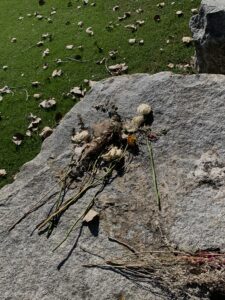Chapters 4-10 of Persepolis were a lot more intense than the previous chapters. The narrator is trying to navigate living through revolution, and she is seeing/hearing about a lot of violence. She has family and family friends that are arrested, tortured, and killed. The political state is getting worse and worse and there is a not a lot that she can do. This sense of helplessness made her question her god, and it made her angry. She wanted to fight back against the violent political climate but there was not a lot that she could do as a young girl. This is story has made me emotional at times, just because the things she decribes are things that I have never imagined. I think we take a lot of our comforts for granted, and I am grateful that I have not had to experience some of the things that the author had to experience.
Author: Kaylee Wyrick Page 2 of 4
Something I noticed about telling a story in a graphic format is the way it makes it easier to see exactly what the author wants you to see. For example, in the last box on the third page, the author describes how her mother wore glasses for a long time because she was trying to hide her identity. The illustrations of men’s faces looking at her in a menacing way add a lot by showing what the mother was going through and why she was so scared to begin with. There is still room for imagination, but when there are illustrations to go along with the story it adds to the experience of reading. There is a stronger connection between the story and what the story is trying to convey or explain. Graphic format is easier for me to read, and I think that graphics are a positive addition to a story.
Angelo’s Daily Class Notes can be found here: https://blog.richmond.edu/storytelling2023/2023/10/24/daily-class-notes-10-24/
- We started the class by sharing comments/concerns regarding this course in the Spring semester. It is going to be held on Fridays, and it will be worth half of a credit. There will also be opportunities for an alternative assignment/time for those who won’t be able to make the Friday afternoon classes work with their schedule.
- Talking about our field trip was great since we did not get an opportunity to after it was over since many people had classes to go to and were rushing. We went over prep notes and were able to discuss the complex feelings and ideas that were brought up while visiting the burial site. Many people mentioned how they noticed signs and areas of the burial ground in disrepair. We talked about the history of slavery in Virginia and how measures are being taken in order to acknowledge the atrocities committed. Everyone in the class had different experiences while learning about the darker parts of our nation’s past.
- Finally, we talked about our midterm and what is expected. There are two papers to write, and they should be about 2-3 pages long.
One thing I noticed about how the author tells the story is her inclusion of vivid metaphors. I think well-written metaphors add a lot to a story and help the reader better understand and imagine what they are reading. The metaphor that stuck out to me the most was the one about how “the revolution is like a bicycle when the wheels don’t turn it falls”. I thought this was extremely powerful due to the emotion it carries behind it. I thought it was a great way to connect the story to the narrator, a child who wants better for her country.
- How long should the papers be? My draft is 3 pages but I don’t know if I need more or less.
- Do the papers need to be in Chicago style? Or can they be in MLA format?
I took this picture in front of the first monument we saw when we arrived at the burial ground. These flowers were left on a rock that faces a tree where historians think hangings took place. There is no way to know the number of people who were killed there and how many were buried just feet away, but it is still extremely important to show that they have not been forgotten. Seeing the flowers placed there reminded me of how it is common to leave flowers at headstones, but unfortunately, there are no gravestones or markers for the people buried at the site. I think whoever left the flowers meant to honor those who have passed and show that they are still being remembered. This stood out to me because the people buried at the site were forgotten at one point, but that is changing. 
When I started my annotated bibliography, I had trouble finding my source. I chose the book The Color of Their Skin and it was not in the Boatwright Memorial Library even though the website said it would be there. I talked to the librarians and I was able to find a copy at the Richmond Law Library. I read the pages before and after my selected quote, and it was easy for me to come up with a summary of the source. When typing my bibliography I had some issues with formatting and spacing, but I was able to figure it out. I’ve had trouble finding a peer-reviewed source about integration in Virginia schools for my two other sources.
I’ve never had to do any assignments in Chicago style so I was a little nervous, but after reading the format and example link I’m confident that it will be doable. All of my previous teachers have been extremely strict in terms of MLA format so getting used to Chicago format will be an adjustment. I ended up looking up a few other examples on Google which was very beneficial.
I didn’t have a problem finding something in the book that I wanted to learn about, so picking my source was easy. I wanted to learn more about those who were very vocally opposed to integration in schools. On page 162, the quote “…dedicate our every capacity to preserve segregation in the schools” stuck out to me. I knew that people were against integrating schools but I never read about politicians being so openly against it. The source I’m using is The Color of Their Skin by Richard Pratt. The chapter this quote is included in is titled “A Shameful Legacy”, and this is the perfect way to capture what the pages before and after the quote is about. The source is about Brown v. The Board of Education and the effects it had on politics. It also mentions how adamantly some Southerners fought against integration in schools.
Chapters 7-8 were very interesting, and they talked about specifics in Virginia history that I had never heard of. I knew that following the Civil War many southern states enacted black codes or racial segregation but I didn’t know the specifics of it. I thought it was interesting how the different types/effects of racial segregation were broken down. I was surprised to an extent about redlining and its effects. In chapter 8, I was/am interested in learning more about Jackson Ward. The way that urban planning and the city of Richmond failed Jackson Ward’s residence is very concerning. There was no regard for their lives or where they would go. Once again, the black population was ignored and pushed to the side during a decision-making process that would greatly affect their lives. Hearing about the fight against racial integration in schools was sickening. The fact that politicians were so against integration that they were willing to shut down the public school system shows true ignorance.
Chapters 4-6 were very interesting and informative. I previously learned about the Tobacco boom in Virginia in my history classes. Although I knew a little about the tobacco economy and how the slave trade was impacted, I didn’t realize that Richmond was a major hub for it. I was surprised when I learned there was a movement to help freed people return to Africa to Liberia. I was never taught about that, and I had no idea that many died on the voyages. When reading about the religious justification for slavery, I could not help but think about how backward and wrong that was. When I read about the slave revolts I was disgusted to read that a man was skinned like an animal. This stuck out to me because it further showed how black Americans were truly treated like animals. Reading about Devil’s Half Acre and the slave trade in Richmond taught me a lot about how deeply the roots of slavery affected Richmond and how they still linger today. I was not surprised to learn that this long history of slavery was not taught or well-known until the 90s. Overall, I found myself shocked and disgusted when reading about the treatment of Africans and African Americans in Richmond. Unsurprisingly, I was not shocked to read about the laws surrounding slavery and the treatment of anyone who wasn’t a “great man”
